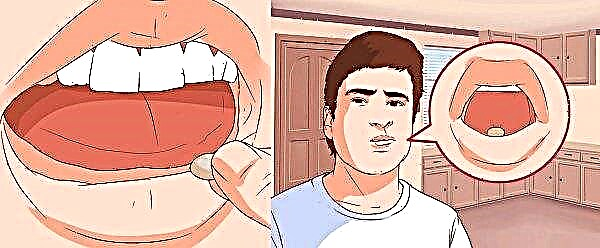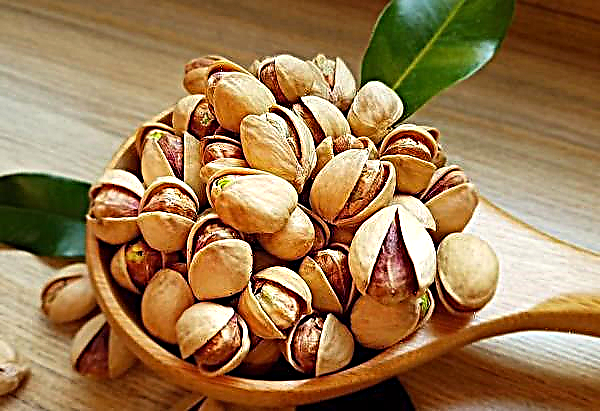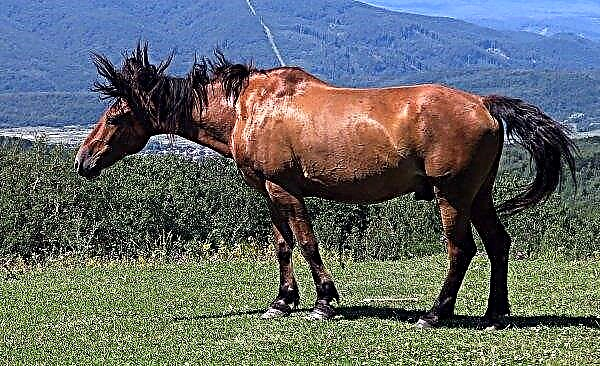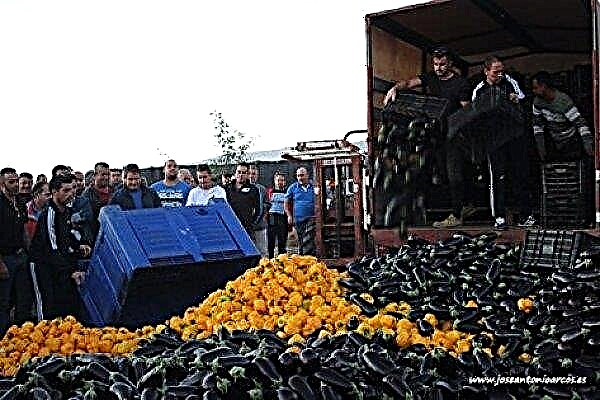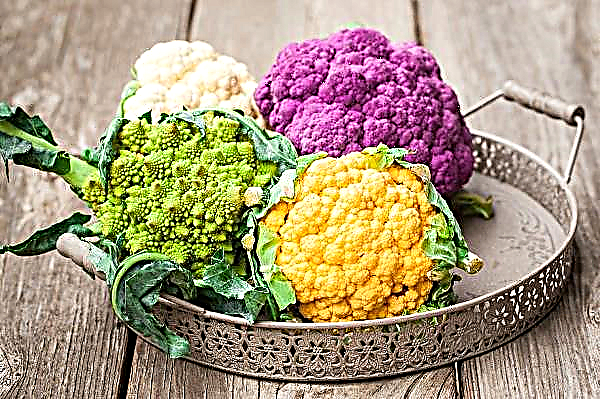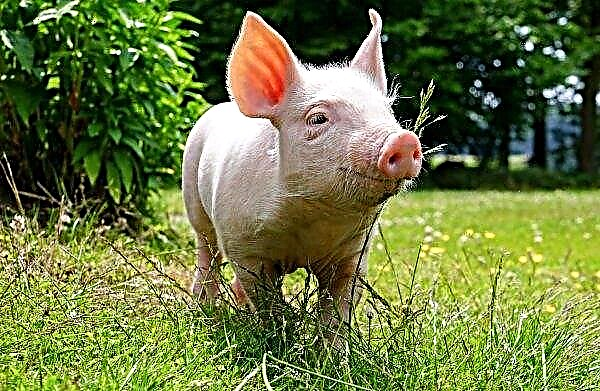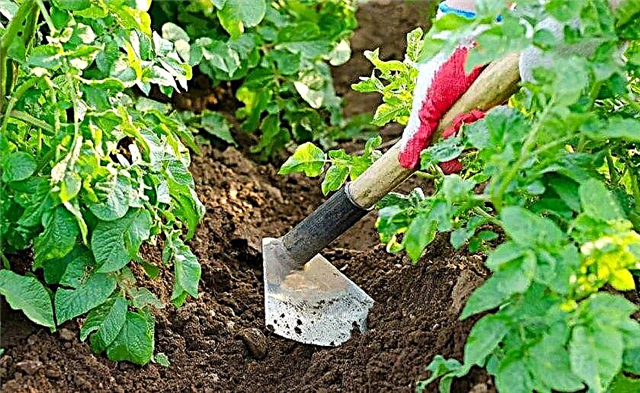Among the many varieties and hybrid varieties of cucumbers, cultivated plants with such an interesting name Mother-in-law may get lost, but this does not mean at all that the culture has nothing to surprise gardeners. Despite the relatively high whimsical care, these cucumbers have a lot of advantages, which can be seen by examining in more detail the basic description of the vegetable and studying its requirements for growing conditions.
Selection Characterization
Hybrid cucumbers of Mother-in-law were bred by Russian breeders from the Research Institute of Vegetable Production of Protected Ground, in collaboration with scientists from the seed company Gavrish, Moscow. The plant got into the State Register of Breeding Achievements of the Russian Federation in 2007, and since then it has been increasingly found in various regions of the state. The developers of the new variety tried hard to adapt it to cultivation not only in the Central, but also in the Northern and Middle Volga regions, so with proper preparation of the site and the planting material itself, growing it in any climate will not be a problem. Mother-in-law F1 is a vigorous plant, with medium lashes and cylindrical greenbacks, which grow to 11–13 cm in length and gain weight up to 125 g each. The surface of the fruit is tuberous and brown, the flesh is dense, without voids and characteristic bitterness in taste.
Mother-in-law F1 is a vigorous plant, with medium lashes and cylindrical greenbacks, which grow to 11–13 cm in length and gain weight up to 125 g each. The surface of the fruit is tuberous and brown, the flesh is dense, without voids and characteristic bitterness in taste.
The first crop can be harvested already 48 days after sowing seeds, and from 1 m² it is often possible to get up to 12 kg of high-quality fruits. All of them have a pleasant and delicate taste, which does not change even after prolonged storage of cucumbers.
Did you know? Features of the peel of cucumbers determine their attractiveness for people of different nationalities. Whereas for Russians, tapered varieties of this vegetable are considered real, European consumers call them “Russian shirts” and prefer fruits with a smooth surface.
Advantages and disadvantages
- The main advantages of the hybrid variety of mother-in-law cucumbers are the following characteristics:
- high taste data;
- increased productivity;
- stage-by-stage ripening of fruits (prolongs the period of harvesting the crop);
- high seed germination rates;
- universality of application (suitable both for fresh consumption and for processing into billets);
- the possibility of growing in any type of soil and in any climatic conditions;
- lack of need for pollination by insects;
- good resistance to powdery mildew and peronosporosis.
- Among the disadvantages of this hybrid variety of cucumbers are:
- the relatively high cost of planting material;
- whimsical care, taking into account the requirements for irrigation, tillage and fertilizer.
Self-growing seedlings
On the greater territory of the Russian Federation, the cultivation of mother-in-law cucumbers involves their preliminary sowing for seedlings, because sufficient heating of the soil is observed not earlier than the beginning or even the end of May. The specific timing of sowing seeds must be taken into account at home, just like the requirements for the preparation of the substrate and the technology of placement of planting material in prepared containers.
Optimum seeding time
Sowing cucumbers in seedlings is carried out about a month before planting at a constant place of growth. The ideal age of young cucumber seedlings for transplanting to the garden is considered to be 20–25 days from the time of seedling sowing, that is, if it is planned for mid-May (air temperature should reach + 22 ... + 28ºC during the day, and up to + 18 ... + 22ºC at night ), then sowing seeds can be done already in mid-April. Lowering these values to + 8ºC, which lasts longer than two days, threatens the destruction of the stands.
The soil
The ideal substrate for cucumber seedlings are light, nutritious soils with neutral acidity. You can buy this soil in finished form (sold in any gardening shop) or prepare it yourself by mixing peat or leafy soil (1 bucket), sand (0.5 buckets) and ash (1 l). Ashes can be replaced with dolomite flour or lime, which is especially valuable when it comes to substrates with high acidity. Also, do not forget that such a mixture will not contain any nutrients, which means that it is worth adding at least 3 tbsp. spoons of any complex fertilizer. In the future, during seedling growth, instead of pure water for irrigation, each time you have to use a mixture of liquids with complex fertilizers (must include potassium, phosphorus and nitrogen).
Also, do not forget that such a mixture will not contain any nutrients, which means that it is worth adding at least 3 tbsp. spoons of any complex fertilizer. In the future, during seedling growth, instead of pure water for irrigation, each time you have to use a mixture of liquids with complex fertilizers (must include potassium, phosphorus and nitrogen).
Alternatively, you can use a mixture of two parts of turf land, one part of compost or peat and the same amount of sand (or perlite). When mixing all components, always try to get a homogeneous mixture, without any lumps.
You can also disinfect the self-prepared substrate by calcining in the oven or spilling it with a weak solution of potassium permanganate.Important! Before use, the ready-made substrate must be decontaminated by placing the bag with it in a bucket of very hot (up to +70° C) water. The bucket must be covered with a lid and in this form, leave the soil until the water cools completely.
Capacity for growing
Almost any capacity is suitable for sowing cucumber seeds. This can be a small plastic box, individual plastic boxes or special cassettes with individual holes. Peat pots will be a good option for placing seeds, but they are not necessary. If seedlings were previously grown in the container, then it should be scalded before re-use.
Seed preparation
Pre-planting preparation is needed not only in the soil, but also in the seeds of the mother-in-law cucumbers. Choosing only high-quality planting material (all seeds should be even and about the same size), it is immersed in a weak solution of potassium permanganate and left there for 30 minutes. After the specified time, it remains only to wash the seeds in clean water and dry them a little before sowing in the soil. Instead of potassium permanganate, you can use special prophylactic drugs (for example, Fitosporin-M), which will help protect future seedlings from root rot and bacteriosis.
For the fast germination of planting material (especially in depleted soils), they are additionally soaked in rooting solutions, such as Epin or Zircon, but not less than for 12 hours.
Sowing
The scheme of planting mother-in-law cucumbers in seedlings depends on the type of prepared container. For example, in separate cups, 2-3 seeds can be placed, deepening each of them by 2-3 cm in the soil. When using boxes, sowing of planting material should be carried out taking into account the necessary distance between adjacent plants: not less than 5 cm. Grooves are made at a distance of 10-15 cm from each other. As for the technology of the process, it provides a standard set of planting actions:
As for the technology of the process, it provides a standard set of planting actions:
- To begin with, the prepared soil is leveled and appropriate grooves are made in it, 3 cm deep.
- Then the soil is moistened a little and the prepared seeds are placed in it, observing the required distance, according to the above scheme.
- At the end of the process, the seeds of the cucumbers are covered with soil and the boxes are covered with glass or plastic wrap.
Seedling Care
For seedlings emerging from the earth, a sufficient level of lighting is an important condition for their normal growth and development. However, it is desirable that it be dispersed, otherwise immature sprouts can get burned. The first watering is usually carried out several days after sowing the seeds, focusing on the condition of the soil: the dried top layer of the substrate is always slightly moistened so that a dense crust does not appear on it. A few hours after making the liquid, the soil in the boxes can be loosened using a small stick or even a match, deepened into the areas between the plants. Before the emergence of seedlings, it is better not to perform the procedure, since there is a high probability of getting planted seeds from the ground. As for fertilizers, for the month of growing seedlings of mother-in-law cucumbers, complex mineral compositions can be used twice, combining their application with the next watering of the plantings. About 2-3 weeks after sowing, the grown plants can be planted from a common box in separate cups (dive). Very weak sprouts should be removed, leaving only strong and healthy specimens.
As for fertilizers, for the month of growing seedlings of mother-in-law cucumbers, complex mineral compositions can be used twice, combining their application with the next watering of the plantings. About 2-3 weeks after sowing, the grown plants can be planted from a common box in separate cups (dive). Very weak sprouts should be removed, leaving only strong and healthy specimens.
About a week before the planting of grown seedlings at a constant place of growth in open ground, it begins to harden. In the early days, it is enough to take out the boxes with seedlings on a closed balcony and leave them there for 1-2 hours, and after another 2-3 days, the time spent by the seedlings in a cool place is increased to 4-5 hours. On warm days, the windows on the balcony can be opened, most importantly, to protect the seedlings of cucumbers from sudden gusts of cold air.
Did you know? The record for growing the longest cucumbers belongs to British pensioner Claire Pearce, who managed to grow a vegetable, 119 cm long.
Planting and growing cucumbers
Growing cucumbers varieties Tescha possible both seedlings and seedlings, each of which, although it has its own characteristics, but at the same time provides for the fulfillment of general requirements: for example, the organization of nutritious soil for cucumbers (rotten humus, manure and superphosphate, which are sometimes better replaced with wood ash), are introduced into depleted soils. The acidity of a suitable substrate will always tend to zero, and friability should be at the highest level. In already used soil, cucumbers can be re-grown no earlier than 3-4 years later. As for the specific features of seedlings and seedlings, it is important to consider the following features.
The acidity of a suitable substrate will always tend to zero, and friability should be at the highest level. In already used soil, cucumbers can be re-grown no earlier than 3-4 years later. As for the specific features of seedlings and seedlings, it is important to consider the following features.
Seedling method
For seedlings, mother-in-law cucumbers are sown in the middle or end of April, pre-preparing the soil and the seeds themselves as described above. At the stage of formation of 3-4 true leaflets (approximately 25 days from sowing), the plants are already ready to transplant to a constant place of growth, which on average falls in the middle or end of May, when the threat of return frosts completely passes. Planting seedlings on the beds is carried out according to the scheme 50 × 50 cm, which guarantees sufficient space for the growth of any bush. For several hours to move the grown cucumbers, it is useful to spill them with warm water, which will facilitate the process of extracting seedlings from seedlings. For the successful adaptation of young plants in new soil, its temperature should be at least + 13ºC, and as for the suitable planting time, then it is worth paying attention to cloudy weather, without direct exposure to the soil in direct sunlight.
For the successful adaptation of young plants in new soil, its temperature should be at least + 13ºC, and as for the suitable planting time, then it is worth paying attention to cloudy weather, without direct exposure to the soil in direct sunlight.
In harsh climatic regions, over vertically planted sprouts (each plant should take a stable position) it is useful to stretch a temporary film shelter that protects the cucumbers from possible return frosts.
In a reckless way
In warm regions, it is often practiced to sow cucumber seeds directly into open soil, so the planting dates in this case will be slightly shifted: around the end of May or early June. On a previously dug up, fertilized and loosened bed, it is necessary to organize furrows with a depth of about 4–5 cm. For successful growth and development of cucumber bushes, at least 2–3 plants must be on 1 m² of territory. You can also perform the sowing of seeds by the tape method, that is, according to the scheme 50 × 90 cm
When sowing seeds, the soil temperature at a depth of 8 cm should be at least + 8 ... + 12ºCthen, on light substrates, planting material is embedded 6 cm in depth, and on well-moistened soils, you can not deepen seeds by more than 5 cm. On heavy and dense soils, you can sow mother-in-law cucumbers to a depth of not more than 3-4 cm. frost can additionally cover the crops with a film cover, which will only accelerate the emergence of seedlings. As soon as the young plants are a little stronger, the film can be removed so that the sprouts can warm up well in the sun. The place chosen for cucumbers should be well-lit and protected from cold gusts of wind. In addition, make sure that no cucumbers, pumpkins, squash, melons, watermelons or other cucumbers are grown on it before cucumbers. More successful predecessors for plants of this variety will be tomatoes, onions, potatoes, carrots, legumes.
The place chosen for cucumbers should be well-lit and protected from cold gusts of wind. In addition, make sure that no cucumbers, pumpkins, squash, melons, watermelons or other cucumbers are grown on it before cucumbers. More successful predecessors for plants of this variety will be tomatoes, onions, potatoes, carrots, legumes.Cucumber care after hanging
After planting in open soil, further care for Tescha's cucumbers provides for the implementation of standard actions in the form of timely irrigation and top dressing, loosening the soil and other measures to improve the condition of both the cucumbers themselves and the soil on which they grow.
Top dressing and watering
The first moistening of the soil after transplanting seedlings to a constant place of growth is carried out only after 2-3 days. In general, the period of active watering of cucumbers stretches from the time of the appearance of the first seedlings to the fruiting of the plant, after which the amount of liquid introduced must be significantly reduced.
Before the appearance of the ovaries, the irrigation regularity is 1 time in 2-3 days or as the top soil layer dries (it should not crack and over-compact). One adult bush should account for at least 2 liters of liquid settled in the sun, which is gently poured under the root of the cucumbers. As fertilizers, which it is desirable to apply to the soil soon after irrigation with warm water, you can use mullein diluted in water (1:10) or bird droppings in a ratio of 1:20. Of the mineral top dressing, potash, phosphoric and complex fertilizers will be useful for the mother-in-law. The most effective result from the use of nutrients can be obtained only with a combination of organic and mineral components: before the start of the growing season, vegetables need nitrogen-containing substances more, when flowering plants - phosphorus top dressing, and at the peak of fruiting - potassium-containing compounds.
As fertilizers, which it is desirable to apply to the soil soon after irrigation with warm water, you can use mullein diluted in water (1:10) or bird droppings in a ratio of 1:20. Of the mineral top dressing, potash, phosphoric and complex fertilizers will be useful for the mother-in-law. The most effective result from the use of nutrients can be obtained only with a combination of organic and mineral components: before the start of the growing season, vegetables need nitrogen-containing substances more, when flowering plants - phosphorus top dressing, and at the peak of fruiting - potassium-containing compounds.The variety does not interfere with periodic (1 time per month) foliar top dressing with a solution of 1 liter of water, 1.5 g of potassium permanganate and the same amount of boric acid. As for the regularity of fertilizers, then in the growing season of cucumbers they should be carried out no more than 1 time in 2 weeks.
Important! During the formation of the ovaries and the beginning of fruiting, nitrogen-containing compounds that contribute to increased growth of leaves and stems to the detriment of fruit growth will be especially undesirable for plants.
Bush garter and shaping
Despite the fact that the bushes of this variety of cucumbers are not too tall, the length of their lashes often reaches 2 m, which means that they still need a garter to the support, which will help significantly reduce the likelihood of decay of fruits in the ground. In addition, well-ventilated parts of the plant will not suffer from pests and fungal diseases, therefore, as soon as the first whiskers and stems with 5-6 leaves appear on young bushes, you will have to tie them up.
In greenhouse conditions, the easiest way to accomplish this task would be to tie the plants to twine stretched between the metal reinforcement laid on the ground and the same section fixed under the roof of the greenhouse. In open soil, instead of it, you can stretch the mesh, with large cells.The stems of growing cucumbers should be regularly wrapped around the support clockwise, which repeats the trajectory of the sun through the sky (all plants stretch towards it). The formation of plants begins almost simultaneously with their garter. Variety of mother-in-law usually grows in a single stem, often not limited to its natural length. You can control the yield of shoots using stepchildren that appear on the main stem. If the installed trellis or the height of the greenhouse requires limiting the growth of the crop, then pinch the top of the cucumbers and leave all the stepsons on the plant. If you are more interested in the high abundance of the crop, then you will have to remove all stepsons and collect fruits only from the main part of the bush.
The formation of plants begins almost simultaneously with their garter. Variety of mother-in-law usually grows in a single stem, often not limited to its natural length. You can control the yield of shoots using stepchildren that appear on the main stem. If the installed trellis or the height of the greenhouse requires limiting the growth of the crop, then pinch the top of the cucumbers and leave all the stepsons on the plant. If you are more interested in the high abundance of the crop, then you will have to remove all stepsons and collect fruits only from the main part of the bush.
Important! The more lateral shoots in the culture, the more light, water and nutrients are required, not to mention a sufficient place for growth, which is not always convenient.
All flowers and stepsons formed in the sinuses of the first 5 leaves should always be removed, and if you decide to leave the stepsons, then you will have to pinch them over the second leaf to a height of 1 m. At a height of 1 to 1.5 m, such shoots pinch over a 3-4 leaf, and the uppermost stepsons - over a 5-6 leaf. The central shoot, having reached the maximum length, needs to be thrown over the crossbar and left to grow down. It is advisable to remove leaf plates growing from below as the bush grows, so that they do not get dirty with earth and do not cause the development of fungal ailments.
Soil care
Given the high frequency of watering during the growing season of Tescha cucumbers, the first thing to pay attention to when caring for the soil is loosening the top layer at some distance from the stem part. It is advisable to carry out the procedure every week, but without deepening the tool by more than 10-15 cm. At the same time as loosening, weeds can also be harvested, but in truth, they are scary only for young and not yet strong crops. In the future, with moderate thickening of the plantings and proper garter of the cucumbers, there should be no problems: weeds can be removed 3-4 times during the entire growing season. Mulching and hilling of cucumber bushes is carried out after the introduction of the next portion of the liquid, but most often these procedures are performed only when there is a possibility of increased evaporation of moisture from the soil.
Mulching and hilling of cucumber bushes is carried out after the introduction of the next portion of the liquid, but most often these procedures are performed only when there is a possibility of increased evaporation of moisture from the soil.
Pest and Disease Control
As in the case of other hybrid varieties, you can grow mother-in-law cucumbers without actively combating pests and diseases, especially if from the moment of sowing the seeds and until the harvest, the gardener clearly follows all the requirements of agricultural technology. In rare cases, small spots of brown-olive color can still appear on the leaves and shoots of the culture, indicating the defeat of cucumbers by peronosporosis (downy mildew). At the initial stages of the development of this ailment, treatment with whey will help get rid of it, but in order to play it safe and protect your cucumbers from mass damage, it is worth using more effective, special fungicidal preparations (for example, Fitosporin-M or Gamair). In the first case, the working solution is prepared at the rate of 40-50 ml per 10 liters of water, and in the second - 10 tablets are dissolved in 10 liters of water.
At the initial stages of the development of this ailment, treatment with whey will help get rid of it, but in order to play it safe and protect your cucumbers from mass damage, it is worth using more effective, special fungicidal preparations (for example, Fitosporin-M or Gamair). In the first case, the working solution is prepared at the rate of 40-50 ml per 10 liters of water, and in the second - 10 tablets are dissolved in 10 liters of water.
When signs of putrefactive processes appear on the stems of cucumbers, you can treat the plants with compositions containing chalk, water and potassium permanganate, which are first applied to a cotton swab, and then the plant itself is treated. Affected areas of the culture must be removed, which will serve as a good prevention of the further spread of the disease on the site. Additional preventive measures are:
- compliance with crop rotation rules;
- timely removal of all plant residues from the beds;
- weed control;
- compliance with irrigation and top dressing.
Video: Prevention of diseases of cucumbers folk remedies
Harvesting
The hybrid variety of Mother-in-law cucumbers is characterized by gradual ripening of fruits, that is, the maximum amount of the crop indicated by the manufacturer on the package with seeds, you can collect not for one or two times, but for the whole season. To get the most crisp and fragrant fruits of small sizes, you will have to pick greenery every 2-3 days, not allowing them to outgrow.
Freshly picked fruits can be stored in the refrigerator or basement for no longer than a week., therefore, those who want to prepare Zelentsy for the winter will have to resort to the standard method - conservation. To bookmark the fruits for storage fresh, they must be wiped with a damp cloth and placed in an airtight plastic bag. Before canning, it is recommended to soak the greens in cold water for 8 hours, changing the liquid to fresh every 2 hours. For salting, no special preliminary preparation is required and after cleaning, you can immediately send the fruits to the jar.
Did you know? Cucumbers can be used not only for culinary purposes. Try to wipe the mirror in the bathroom with a cut fruit, and you will get rid of the problem of fogging while taking a bath.
Hybrid cucumbers of Mother-in-law are a good option even for beginner summer residents, because, despite the increased demand for care, the crop of Zelentsy always pleases with its quality and abundance. Agree, this is a significant reason to grow a culture on your site.

